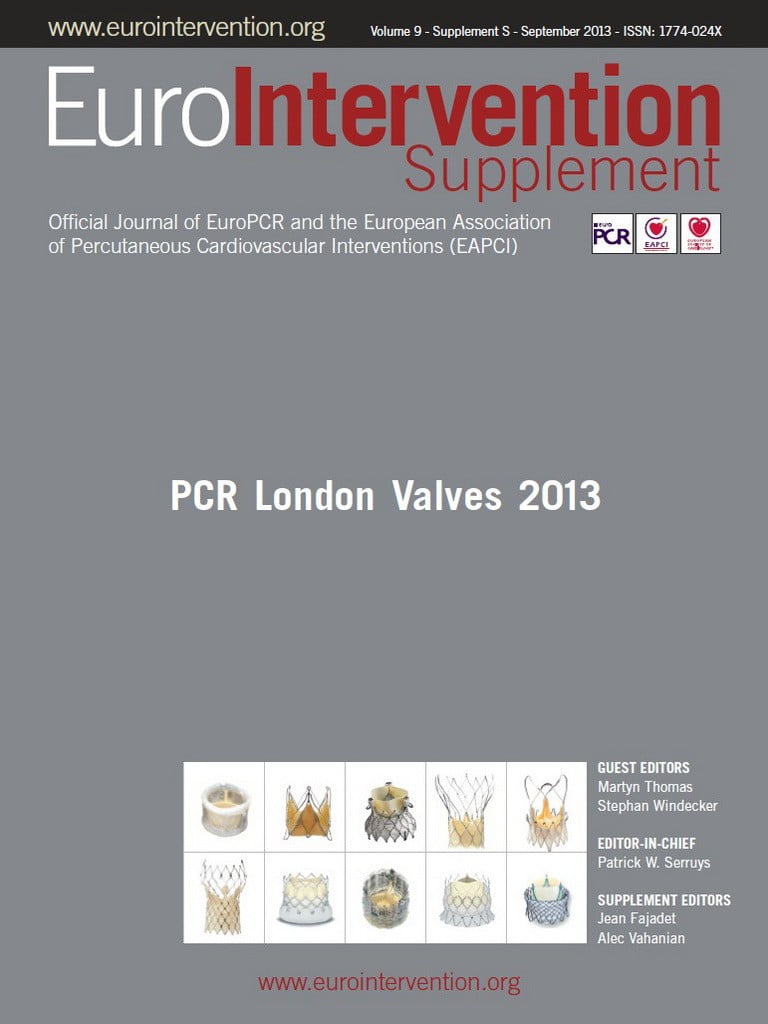Last year, in introducing the first PCR London Valves supplement, we explained that a supplement has a different role than a regular edition of EuroIntervention journal itself. With their specific focus and highlighted targeted contents, these supplements have a key educational value, allowing them to concentrate on one problem or technique and providing a reference document that is of both clinical importance and practical use. Besides PCR London Valves 2012, in the past we have published supplements dealing with subjects as diverse as bifurcations, bioresorbable stents, drug-eluting balloons and the Stent for Life Initiative. Earlier this year we published –to complement the first course of its kind– the Resistant Hypertension Supplement….and now our work continues with this second PCR London Valves supplement.
Last year’s first edition of this supplement captured the state of the art in a rapidly evolving area of our practice and was well received, so why do another one so soon? What has occurred over the last 12 months that would justify –in such a short a time– a new edition on the same subject?
TAVI has been growing at a rapid pace; the evolution in the acceptance and use of TAVI interventions throughout the world simply means that our clinical experience has been growing exponentially as well. With this increase in experience comes an obligation to truthfully –and with a critical and open spirit– confront the emerging data…and to do this requires more than one article. It requires a dedicated forum to present the latest data, the new devices, as well as the ongoing problems that still need to be addressed. We believe that this supplement –a perfect complement to the hands-on approach of the PCR London Valves course itself– is essential.
Success and ongoing challenges
The articles in this current supplement will bring us up to date on where we stand at the present time in this evolving field, and act as a reference in valvular heart disease.
Today, as we examine the data and evaluate the results, we have to look critically at the outstanding difficulties related to these techniques: for instance, paravalvular leak, residual aortic regurgitation, strokes…the need for cerebral protection or the optimal antithrombotic therapies to be used.
The new technologies need to be properly introduced, sharing our experiences with the latest valves in their clinical or experimental settings. We need to compare and contrast our experience as it applies to the different access routes, again sharing our knowledge and practice.
New indications need to be considered: the role of TAVI in native aortic regurgitations or the valve-in-valve techniques in the treatment of failed surgical bioprostheses. What should be the timing and strategy of TAVI and PCI in patients with aortic stenosis and coronary artery disease? Should there be an evolution in indications for lower-risk patients: TAVI was originally intended for use in very sick patients, patients who needed surgical aortic valve replacement, but were at high surgical risk. Are we now prepared to enlarge the indications to include intermediate-risk patients? What are the implications of this? Is there a future for transcatheter valve implantations in patients with mitral disease?
This discussion on indications naturally leads us to the role of economics, and how what we do today fits into a more global concept of healthcare. What is the cost-effectiveness of these procedures? What is their value today in terms of the type of healthcare our societies can offer…and afford?
This supplement will touch on all these topics, providing an excellent complement to the fine work of PCR London Valves, once again under the able direction of Martyn Thomas and Stephan Windecker.
The spirit of continuity and innovation
Along with the evolution in TAVI has come the important realisation that what we do, we do most effectively as a team. The concept of the Heart Team, which was brought to prominence with the advent of these procedures, has now become an ingrained part of our best practice and is due, in great part, to the excellent collaboration and participation of other specialities such as cardiothoracic surgeons, anaesthetists, geriatricians.
Sharing and working together is a key aspect of PCR London Valves and is captured, as well, in the spirit of “PCR” itself, which refers to the position of this course, not only as an official course of the EAPCI, but as an integral part of the PCR Family of educational programmes. There is something special in what we are doing here, both in our commitment to the dissemination of knowledge and experience and to the creative transmission of education and practice for the participants.
At PCR London Valves, as in all the projects of the PCR family, there is an emphasis on this idea of sharing experience, with the common goal of an educational programme made by you and for you. When you participate at PCR London Valves, when you have experienced the live transmissions, the Live in-a-box, interactive analysis of clinical cases, data presentations, cutting-edge introductions of new devices, technologies and techniques, when you return to your cathlabs, the goal is that you take back a new level of treatment, that you can say that you have learned something useful and that you have seen ways to improve your own practice and, using what you have learned and “taken home”, you can provide better outcomes for your patients.
This supplement has been designed as a reference and, while allowing you to build and support the strong foundations created during the course, it also acts as an independent source for the experience shared and the spirit of PCR London Valves itself, furthering the goals of the EAPCI to improve the treatment of cardiovascular disease everywhere.

